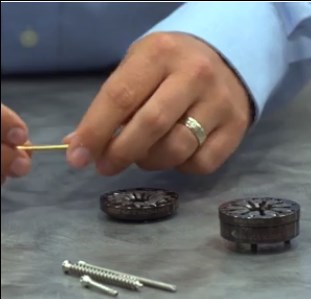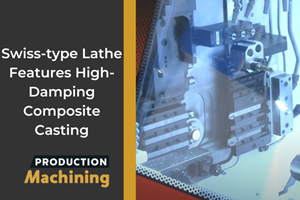VIDEOS: Tips for Screw Making on Swiss-Type Machines
Here’s a three-part video series focused on Swiss screw making to help explain the benefits of thread whirling, back turning and broaching while taking into consideration CAM programming, tooling and machine specifications.

If a high percentage of parts in a shop have threaded profiles, thread whirling is worth considering, as opposed to single-point threading.
Today’s range of CNC Swiss-type lathes have more capabilities than ever before. They are becoming more prevalent in the market, as more companies are discovering the benefits these sliders can bring to their organizations.
A common application is producing screws, often for the medical industry. These can range from bone screws to orthopedic implants. The fact that these machines can achieve tight tolerances makes them well suited to screw making. As cutting occurs close to the guide bushing, the material being cut is better supported and basic mechanics tells us that better support means less deflection. Stationary tools and a sliding headstock mean that parts with a larger length-to-diameter ratio can be produced.
Increased Throughput
But it’s not solely precision alone that makes these CNC machines appealing. With the onset of smaller lot sizes and shorter deadlines for micro-components, there’s more of a need to increase throughput. Due to the multitasking nature of Swiss machines, process synchronization is certainly one way to achieve productivity gains. The option of either synchronizing multiple tool posts on the same spindle (such as pinch milling or follow turning), or on opposing spindles is a great way to lower cycle times and increase throughput.
Tooling
Another is influenced by tooling. There are often numerous ways to machine a screw on a Swiss machine. Take for example threading; if a high percentage of parts in a shop have threaded profiles, thread whirling is worth considering, as opposed to single-point threading—whirling inserts and holders, rather than a dedicated machine. It may well be more cost-effective given the batch size to invest more money upfront on this type of tooling for a higher return on investment. This is achievable through the benefits typically associated with thread whirling:
- Faster machining of deeper thread forms like Acme
- Prolonged tool life due to the increased strength on the cutting edge of a whirling insert
- More productivity by removing the need for multiple passes
- Reduced deflection through improved rigidity and support, helping to machine longer threads
The same consideration can be applied to turned profiles. The objective is to achieve a finished surface that conforms to the design specification by only using a single pass. This can be a challenge when using conventionally angled turning inserts to turn a shape like a screw head, as there can be issues with clearance when machining past the large diameter. This is where back turning tools come into play with their unique geometry and cutting characteristics.
Back turning can not only provide more clearance when machining past a larger diameter, but can also introduce other benefits to the process. When using wiper geometry, the front side of the tool essentially cuts and the backside burnishes. This adds strength to the leading edge and leaves a high surface finish, removing the need for secondary operations.
Polygonal Shapes
One of the final steps of Swiss screw machining is cutting an often polygonal shaped internal drive feature on the back of the screw head. This drive feature is what later houses a hex or Allen wrench to tighten the screw. To avoid any internal radii in the corners of the drive feature (sometimes seen with polar milling), a common technique used is broaching. Rotary or wobble broaching is an efficient method for cutting these types of polygonal shapes. The cutter and spindle are synchronized, allowing for a single operation to create the finished shape. Other types of broaching include index punch or static.
Autodesk, Inc., Genevieve Swiss Industries, Inc. and Tsugami/REM Sales LLC have teamed up in this three-part collaborative video series focused on screw making to help explain the benefits of thread whirling, back turning and broaching while taking into consideration CAM programming, tooling and machine specifications. The first video (above) shows thread whirling operations.
Here is the second video about broaching:
Here is the third video about back turning:
Related Content
Getting More Production From Swiss Turning Centers
Buying a new CNC Swiss turning center is a substantial investment. For the best return, look closely for capabilities that enable the best utilization of the machine.
Read MoreVideo Tech Brief: Swiss-type Lathe Features High-Damping Composite Casting
A rigid casting design and chip control technology are among the various benefits of this Swiss-type lathe.
Read MoreDoes a Scanning Probe Make Sense on a Swiss-Type?
Swiss-types have limited tooling capacity, but there can be advantages to giving up some of that capacity to take advantage of a touch probe — in fact, a scanning probe — to enable in-process part measurements.
Read MorePursuit of Parts Collector Spearheads New Enterprise
While searching for a small parts accumulator for Swiss-type lathes, this machine shop CEO not only found what he was looking for but also discovered how to become a distributor for the unique product.
Read MoreRead Next
New Accessories Improve Swiss Machine Performance
The sliding headstock machine design is well over a century old. Yet it continues to be renewed with developments in the application and performance of accessories within the machine.
Read MoreStill Learning After 102 Years
It’s said that successful people endeavor to maintain the mentality of being a student for a lifetime. Under four generations of family ownership, and a century-plus in business, Nolte Precise exemplifies this philosophy of always learning as it applies to a modern metalworking shop.
Read MoreLocked and Loaded for Further Growth in Firearms Production
Even with a strong and varied manufacturing background, it wasn’t until a few years ago that this father and son team found its way into the manufacture of weaponry components. Nonetheless, business is booming.
Read More












.jpg;maxWidth=300;quality=90)








